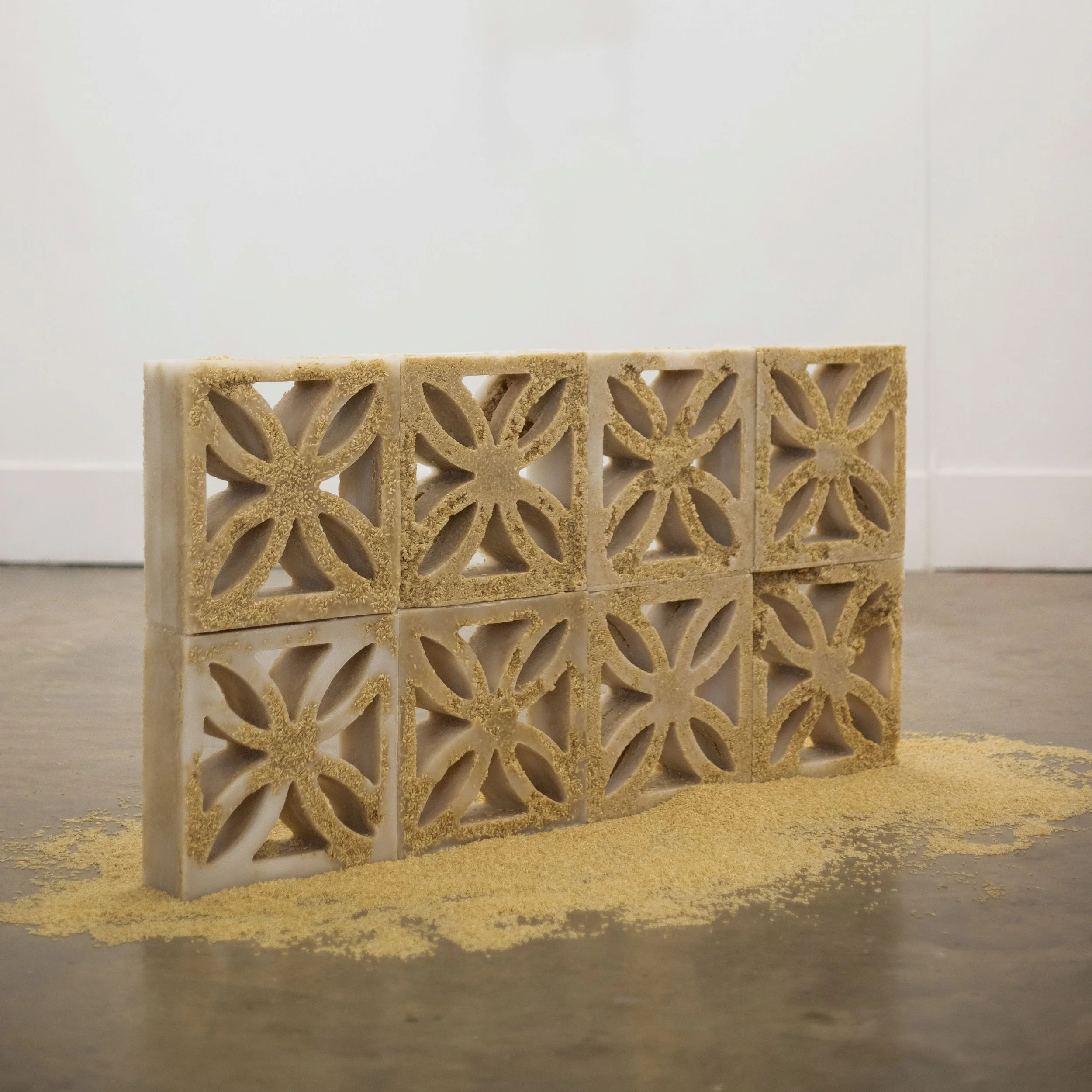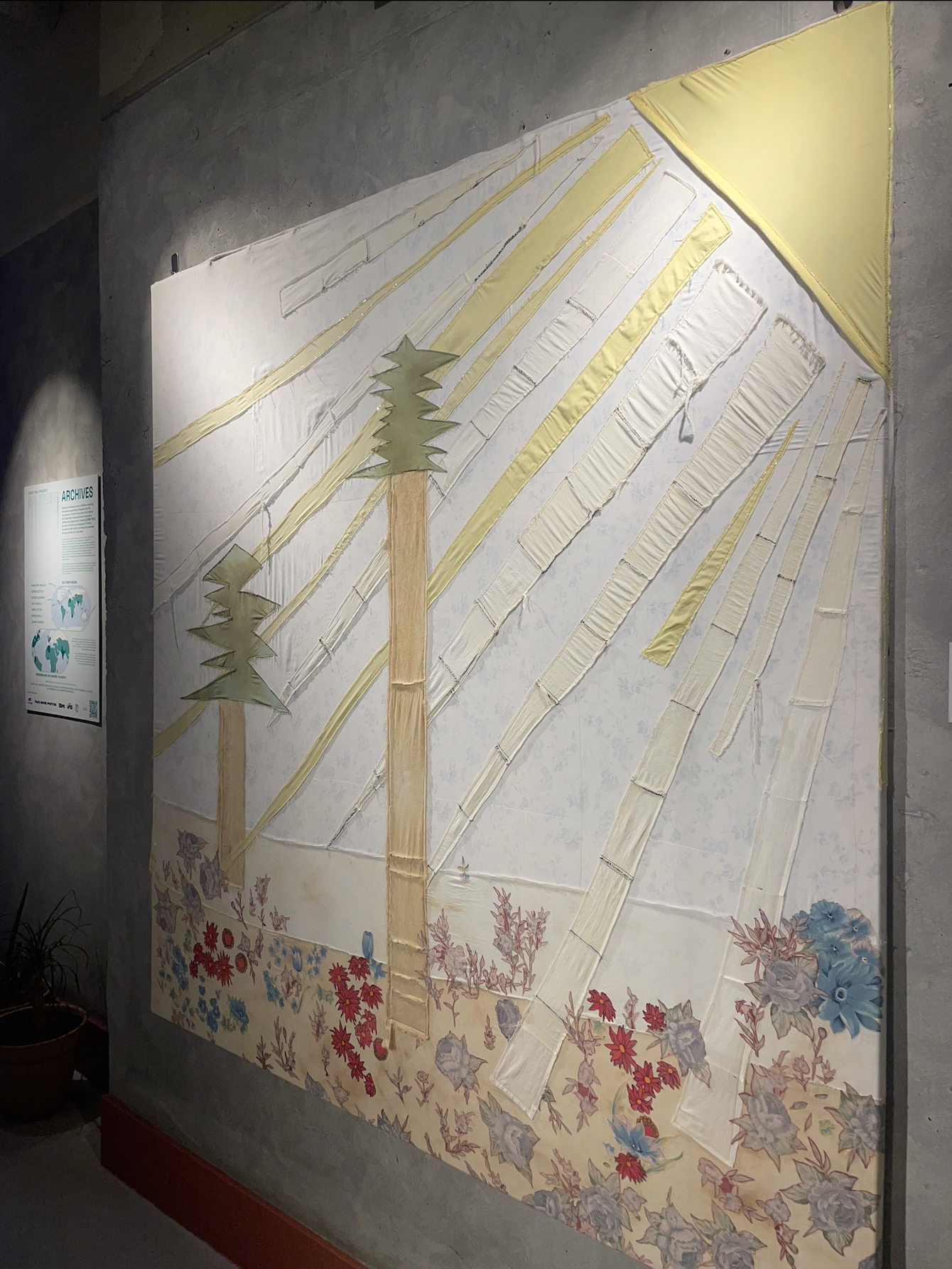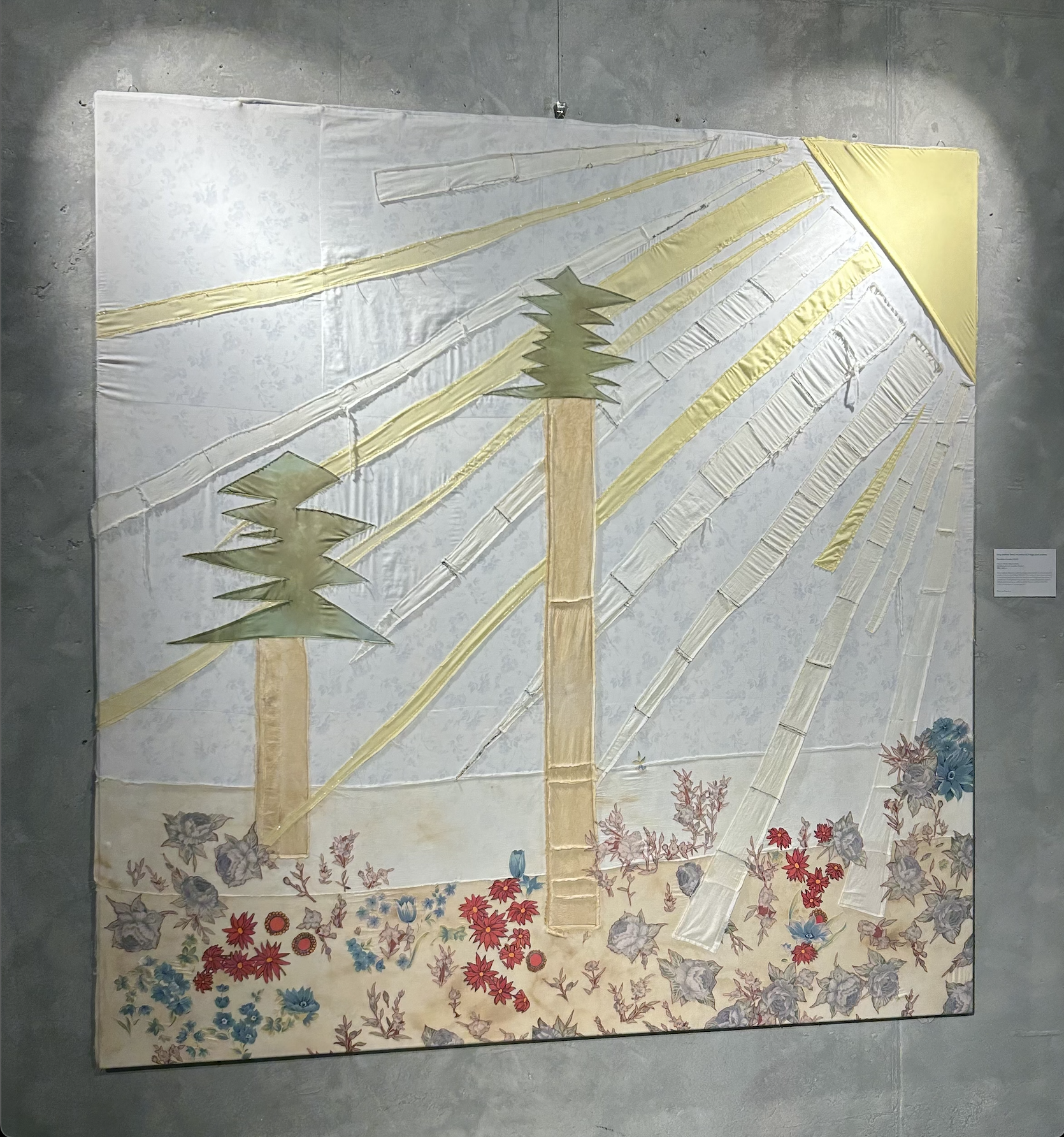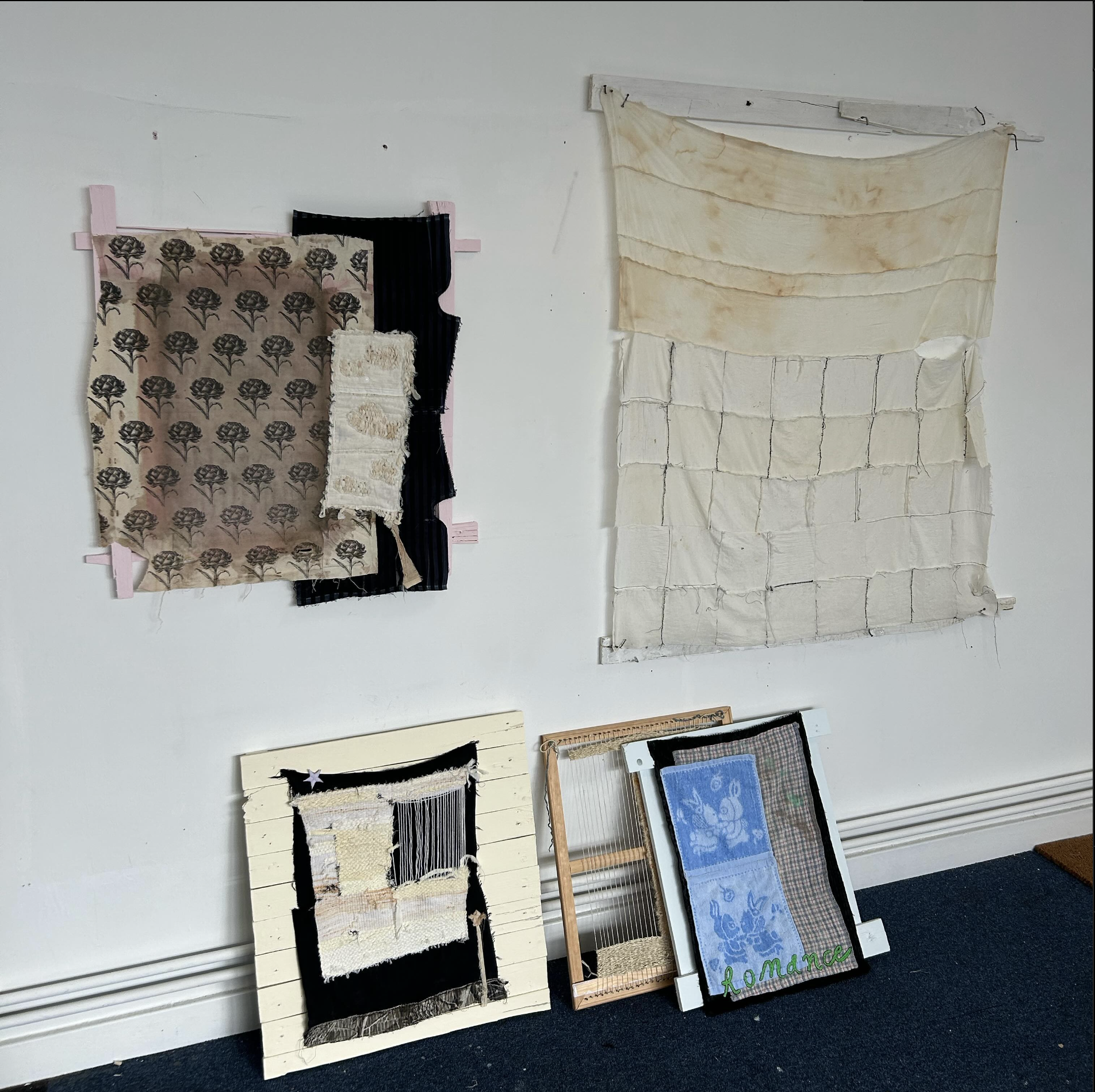Kamalishe Hiraldo
When you walk into Kamalishe Paola Hiraldo’s studio you find finished artworks eagerly poised for their next exhibition, materials in progress being meticulously worked on, and across the walls photographs, saved wedding invitations, and children’s drawings all carefully curated to cultivate Hiraldo’s creative musings. As you comb through the visual archive Hiraldo has built you might ask “where does this archive stop, and her artwork begin?”
As I have grown more familiar with Hiraldo’s practice, it has become evident that the artwork is influenced by the archive she is building as much as it is an extension of it. Making new pieces with source material from her vast array of ephemera is indeed adding to the archive itself. The artwork and her archive simultaneously exist in an arena where past and future become disjunctive and entangled in each other, communicating together and separately. When Hiraldo pursues a new body of work it is as if she is both splitting and conjoining what was, what is, and what could be.
Through this mode of making, Hiraldo is testing our understanding of contemporary art practice as being finished products we put in a white-walled gallery. She offers us something richer and more heavily weighted in the human experience of remembering. As Hiraldo understands it, memory does not work linearly, but instead, it is entangled in references, previous points of recall, and our perception of time. Hiraldo’s work is distinguished by a particular energy that conveys movement in physically static pieces. The works are in a constant state of reconfiguring, becoming, and being understood.
This is evident in ‘king snakes eat rodents, frogs and snakes”, a piece most recently exhibited in Green Table’s Southern Archives group show in July 2024. The textile collage is one of many in a series titled ‘A+ 100:’. For this body of work, Hiraldo has collected her sibling’s childhood drawings and reinterpreted them into fever dream landscapes. This work, in particular, depicts a rose garden with trees, flowers, and sun rays in unseemly proportions. Her technical skill is clear, with child-like scenes executed with sophistication and meticulous attention to detail.
‘king snakes eat rodents, frogs and snakes” would not exist without the original childhood drawing. The artist’s reliance on the reference of the drawing to create this piece puts a particular weight on the drawing. She’s making a statement that something new cannot come about without referencing the past. In doing so, Hiraldo places her sister’s drawing in the intersection of artwork and archive. Accompanied by the reinterpreted textile, the drawing and the collage exist separately and as one, constantly referencing one another.
Throughout her practice, Hiraldo shows a sensitivity to materials that offer reverence for their cultural, personal, or political significance. Hiraldo herself describes this as “charged-material” meaning the material itself holds memory and conveys feeling. For her installation, ‘dios comiendo arroz’, exhibited in Season Gallery’s Summer SZN show, and highlighted as part of Whitechapel’s Noctural Creatures programme, the artist built breezeblocks out of wax and brown rice. These materials are references to religion, architecture, and culture in the Dominican Republic. Rice being a staple in Dominican cuisine the work quite literally builds on top of these memories. The work is constantly referencing its materiality, and it is these layers of specificity that “charge” the material and give it a pulse that radiates past its physical purpose.
Kamalishe has created a world that is personal and very specific, but simultaneously universal as she leads us down a road of discovery with her use of referencing symbols, materials, and culture. She doesn’t follow specific rules or easily fall into a category, but her practice consistently challenges itself and the viewer to form their meaning.
Arhantika Rebello, Founder, QUAKE Digital Magazine
I’m Kamalishe, I’m 28, and I’m an artist. I’m from New York City, I was born and raised there but always say I’m from the Dominican Republic. My parents were both born and raised in the DR, Spanish is my first language and I resonate deeply with the Dominican culture. I’m from Washington Heights in NYC which recently was named Little Dominican Republic. If you ever go there, it’s just like the DR. You go into a pharmacy everyone is speaking Spanish, and in the Summer the men sit outside and play Dominoes all the time. I’ve always identified with being Dominican before even being American, but I know that I am, and always will be, from New York City.
Walk us through your artistic practice and where it all began.
I was always kind of an artsy kid, I was angsty as well, I’m the oldest of my siblings. I had a lot of pressure from my Hispanic immigrant mom and dad to be a doctor, lawyer, engineer or something like that, but I couldn’t help being an artsy kid. When went for my undergrad at Syracuse I was pre-medical track for two almost three years. Then I realised it wasn’t for me, and I switched to a photography minor which is where I started the base of my formal arts training.
When I graduated from my undergrad, I worked a boring marketing job that paid well but I wasn’t happy, and one day I just quit and applied to be a photography studio assistant. Then it all went from there. I sent a cold email to an NYC photographer Jacq Harriet, and I started assisting her full-time, then I started taking my photos, and then I got bored of that. That’s when I moved to London for my MA at Central Saint Martins, and that’s when I started the actual Fine Art hands-on making, sculpting and working with new media and materials.
What’s the next logical step in your artistic practice and where do you see your work evolving?
I think the next logical step will be completing the series I’m working on. I’m working on titled ‘100: A+’. Going larger, which I’ve done already but want to explore further. It’s hard because you need space to produce your work on a larger scale. Collectors don’t want to buy huge pieces because not many have the space, but that’s not the point. I’ve always been drawn to making really really big works. Right now, it’s part of my process to go with the flow and trust my instinct. I use materials I have lying around, I use techniques I know, and I create new ones, so it’s very DIY and I figure it out as I go. I think the next step would be formalising some of those techniques and elevating the technical process of making.
Where do you source your inspiration from?
I get inspiration from my family archives; photos, documents, souvenirs, etc. My dad was a photographer so I’ve always had cameras, and printed 5x7 photos around. I loved to flip through them and still have them all now as part of my archive. I also get my inspiration from everything around me. I get the most out of things that aren’t necessarily art. For example, going out and seeing a child falling into the pond at the park, that’s an interesting moment for me. I’m drawn to the banal and the everyday happenings in life. I’m into cutesy things, like a cartoon, or a childlike drawing. It’s not necessarily always a photo from an archive, it’s mainly an experience of life outside of the context of contemporary art. I find that overconsuming and attempting to constantly produce blocks my brain.
You were recently in a group show where you produced a work from your family archive, can you walk us through the process and how you used the archive to inform the work?
That show was Southern Archives at Bermonds Locke, and it was a group show with several incredible artists in London from the Global South. I made one of my biggest works to date for that show, it’s called ‘king snakes eat rodents, frogs, and snakes.’ It’s based on a childhood drawing that my sister made. I brought this childhood drawing back from NYC to London with me last February when my mom was doing a big cleanout of the closet in her bedroom. She had these three huge folders of our drawings, baby passports, wedding napkins and more that she was planning on getting rid of. So now, I have all of these drawings, mainly my sister’s, and this particular one is of a natural landscape. The drawing has some very funnily shaped trees and several different animals.
I started this piece when I was in a rut, I was stuck and had just come from finishing my degree show at CSM where I made this heavy, hard and fixed structure made of wax and rice. I wanted to explore a softer approach so I went with fabric because it was cheap to source and easy to work with in the limited workspace Io had at the time. The process is very intuitive, I don’t do much planning. I just know if I like the sun I will include the sun, I lay pieces out and if they aren’t working I leave it and take a break. I follow my gut, and if it feels right I just go for it and sew it on, I don't give myself strict deadlines unless I’m working towards a show and that allows the work to come into itself more naturally.
How does your cultural heritage play a part in your art?
My cultural heritage plays a huge part, a lot of the titles of my work are in Spanish. It’s not because I’m making a point, although I guess I am making a point, but primarily I think in Spanish and translating every title into English takes away from the context of my practice. I have a textile work of my grandmother’s house in Higüey, La Altagracia titled ‘calle Santome número 23’ and I don’t feel the need to translate that into English. Most of my work is about the Dominican Republic, it’s about immigration, it’s about being at a birthday party as a child, drinking Country Club soda and sitting on a plastic-covered couch waiting for the food from the birthday party that’s being made in aluminium pans. I don't think about how my culture influences my work because my art is all about that, my cultural heritage is my art.
Do you have any advice for other young artists out there?
Just do it, it’s scary but you have to just do it. One of my professors told me once that, some people are going to love your work and some people will hate your work, but the worst thing ever is if someone doesn't have an opinion about your work. If you don’t do it, no one is ever going to have an opinion about your work. It’s better for someone to hate it and know that you elicit a reaction. You can’t control what people think, it’s scary because art is very personal to the maker, but you can't control it. You just have to be confident and want to do it bad enough that you’re excited even when someone says something negative or critical about your work.










